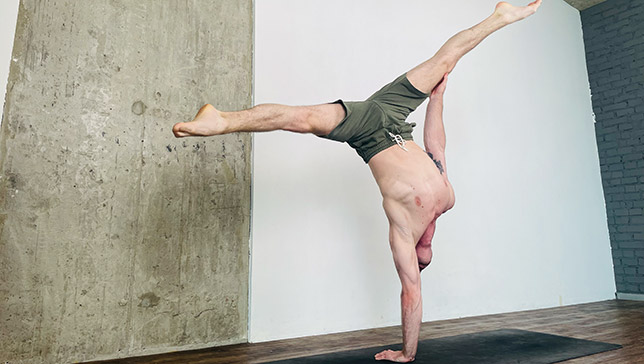One Arm Handstand

Contents
A one-arm handstand, also known as a one-handed handstand, is an advanced gymnastic or yoga pose that requires a high level of strength, balance, and control. It involves supporting your entire body weight on one hand while balancing upside down on that hand. Achieving a one-arm handstand requires a great deal of practice and preparation.
Here are some steps to work towards mastering this challenging skill:
Pose Detail
- Advanced: Handstands
Step-by-Step Instructions
Benefits and Contraindications
Strength and Endurance
Balance and Coordination
Mental Focus
Core Stability
Confidence and Achievement
Preexisting Injuries
Hypertension, heart problems, or neurological disorders
High Blood Pressure
Аnxiety, panic attacks, or other mental health issues
Fatigue or Overtraining
Eating Disorders
Useful Tips
- Counterbalance with Legs:
Use your legs and hips to counterbalance your weight as you shift to one arm. Experiment with leg positioning to find the most stable balance point.
- Engage Your Core:
Keep your core muscles engaged throughout the entire movement to help control your balance.
- Patience and Practice:
– Achieving a one-arm handstand takes time and persistence. Regular practice and patience are key to success. - Safety Precautions:
– Always practice in a safe and open area with a soft surface or crash mats to protect yourself in case of a fall. - Seek Professional Guidance:
– Consider working with a qualified gymnastics coach or yoga instructor who has experience with advanced hand balancing techniques to provide guidance and spot you during practice.
Remember that attempting a one-arm handstand can be risky, and progress may be slow. Listen to your body, avoid overexertion, and prioritize safety during your training. Not everyone will be able to achieve a one-arm handstand, so it’s essential to set realistic goals and progress at your own pace.
Frequently Asked Questions
Mastering a one-arm handstand is a highly advanced skill that requires exceptional strength, balance, and technique. The time it takes to achieve mastery can vary significantly from person to person based on individual factors such as your current level of fitness, prior experience with handstands, and the amount of dedicated practice you put in.
A one-arm handstand requires strong shoulders, triceps, core, and wrist muscles to maintain balance and stability.
Yes, you should have a solid handstand, good upper body strength, and wrist mobility. Progressing through one-arm push-ups and other handstand variations can be helpful.
Balance improvement comes with practice. Focus on your core engagement, gaze, and minor adjustments in finger and wrist pressure to maintain balance.
Common mistakes include overbalancing or underbalancing, not engaging the core, and not maintaining a straight line from wrist to toes.
While a good gymnastics mat is recommended for safety, you don’t need specialized equipment. A flat, stable surface is sufficient for practicing.
Yes, there are various drills and progressions, including one-arm push-ups, handstand weight shifts, and lowering one leg at a time while in a handstand.
While it’s a challenging skill, with dedication and consistent practice, many individuals can learn to perform a one-arm handstand. However, it may not be suitable for everyone, especially those with certain physical limitations or injuries.
Having a coach or spotter can provide valuable guidance and safety. It’s recommended, especially for beginners and those attempting more advanced variations.
Yes, once you master the one-arm handstand, you can explore various follow-up poses and transitions to add complexity and creativity to your practice.
Variations
- One-Arm Handstand with Bent Legs
- Straddle One-Arm Handstand
- Pike One-Arm Handstand
- One-Arm Handstand on Parallettes
- One-Arm Handstand to One-Arm Elbow Lever
- One-Arm Handstand on Various Surfaces
Top Preparatory Poses
Top Follow-Up Poses
- One-Arm Handstand to Planche
- One-Arm Handstand to Straddle Planche
- One-Arm Handstand to Tuck Planche
- One-Arm Handstand to L-Sit
- One-Arm Handstand to Pike Press
- One-Arm Handstand to Handstand Split
- One-Arm Handstand to Handstand on Objects
- One-Arm Handstand to Handstand on Partner
- One-Arm Handstand to Hollow Back Handstand
- One-Arm Handstand to Forearm Stand